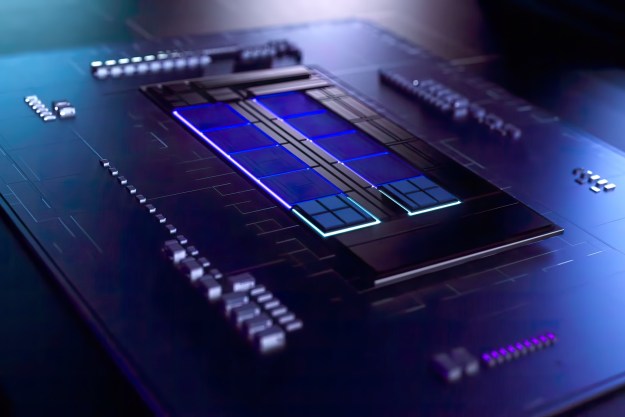
Last night, that all changed, at an Intel press event where the company was finally candid about what was going on with its upcoming computing device. Immediately after seeing it in the context of a slideshow presentation, we were tempted to place a pre-order, though Intel hastily revealed that everyone in the audience would be receiving a test unit free of charge.

Unfortunately, absent from the press samples will be a crucial element to Skull Canyon’s success — the Razer Core external graphics unit that connects to the NUC over a Thunderbolt 3 connection. Without it, you’re stuck with Intel’s own Iris Pro Graphics 580, which should prove quick for integrated graphics, but is unlikely to satisfy most gamers.
With Razer’s GPU housing connected, an Intel rep explained that Just Cause 3 can run at a buttery smooth 60fps at the highest settings, while without the Core, you can expect a mere 30 – 40FPS even with low graphics settings enabled.
That wouldn’t cause for much alarm had Intel not pushed the Skull Canyon as a gaming-centric device, but since it was on display running a high-end triple-A game, there’s little room to deem it a productivity device. In reality, the Iris Pro graphics alone won’t get you nearly as far as a full-size gaming rig, and the $500 price tag that accompanies a Razer Core unit (without a graphics card) is a bit much to ask on top of the $650 Intel says the Skull Canyon will cost.
Nevertheless, neglecting gaming as a factor, the NUC is a competent device. In both size and appearance, it’s vaguely reminiscent of a video game capture card, such as an Elgato. If lugging a monitor around doesn’t bum you out, or if you’re traveling to a place where a monitor is on-site already, the Skull Canyon could serve as the ideal desktop travel companion.
Surely, the built-in hardware it featured here is powerful enough to make for some convenient on-the-go photo/video/audio editing, but our concerns are more of a matter of when you would need a desktop to be portable when none of its required peripherals (mouse, keyboard, monitor, etc.) are.
Nevertheless, it’s telling of the unit’s sheer efficiency when it takes advantage of a 45-watt thermal power solution instead of the usual 28. $650 might be a steep asking price for PC of only 0.7 liters, but the amount it packs inside is impressive, despite appearing to be aimed at the wrong audience. Most gamers I know wouldn’t settle for Iris Pro graphics or even an external GPU over Thunderbolt, but those I know in the creative fields would consider Skull Canyon a welcome addition to their production ecosystems.
Pre-orders for the Skull Canyon NUC are expected to go up on Newegg in April, and we’ll see the devices begin to ship in May.
Editors' Recommendations
- Intel CPU gaming crashes are causing an uproar
- Intel Core i5 vs. i7: Which CPU is right for you in 2023?
- Ryzen 7 7700X vs. Intel Core i7-12700K
- Intel Arc Alchemist may be a lot cheaper than we thought
- Intel Raptor Lake breaks the 6GHz barrier, and it’s not even the flagship


